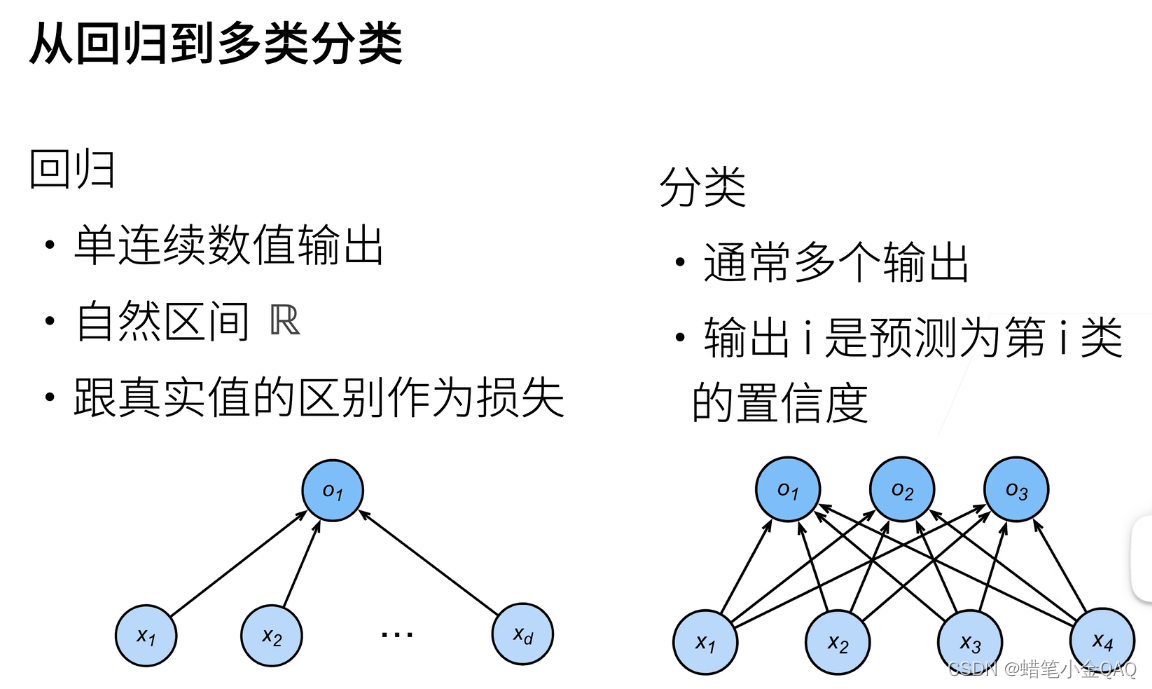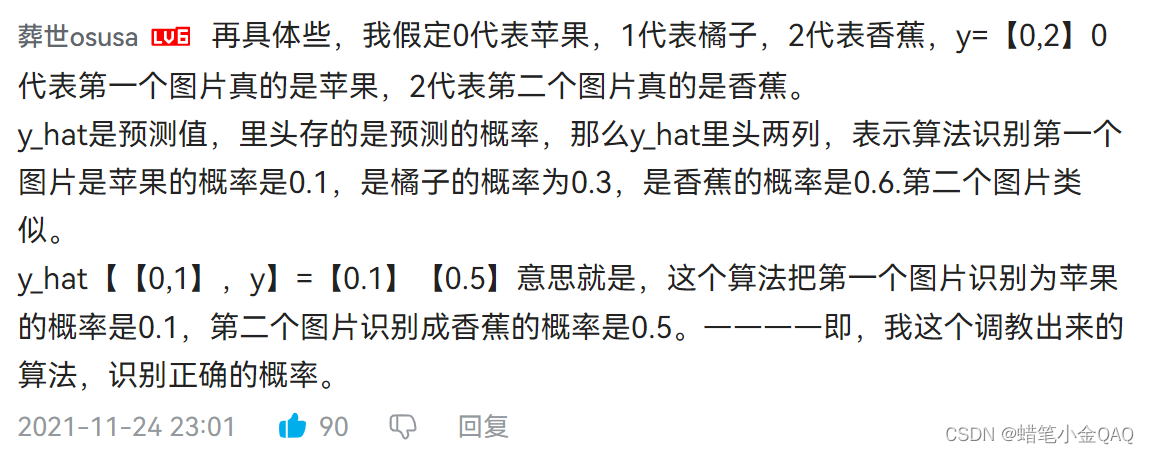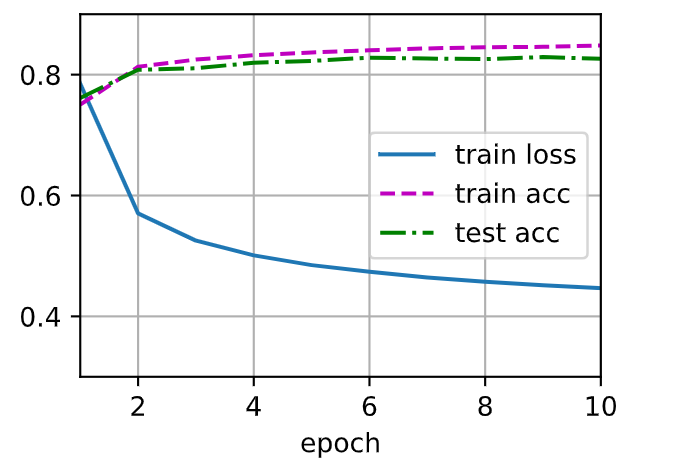Softmax回归
引子
回归可以用于预测多少的问题。 比如预测房屋被售出价格,或者棒球队可能获得的胜场数,又或者患者住院的天数。
事实上,我们也对分类问题感兴趣:不是问“多少”,而是问“哪一个”!

图像分类数据集
1
2
3
4
5
6
7
8
| from d2l import torch as d2l
from torch.utils import data
from torchvision import transforms
import torchvision
import torch
%matplotlib inline
d2l.use_svg_display()
|
下载并读取数据集
1
2
3
4
5
6
7
|
trans = transforms.ToTensor()
mnist_train = torchvision.datasets.FashionMNIST(
root="./data", train=True, transform=trans, download=True)
mnist_test = torchvision.datasets.FashionMNIST(
root="./data", train=False, transform=trans, download=True)
len(mnist_train), len(mnist_test)
|
(60000, 10000)
制定标签
1
2
3
4
5
| def get_fashion_mnist_labels(labels):
text_labels = ['t-shirt', 'trouser', 'pullover', 'dress', 'coat',
'sandal', 'shirt', 'sneaker', 'bag', 'ankle boot']
return [text_labels[int(i)] for i in labels]
|
可视化
1
2
3
4
5
6
7
8
9
10
11
12
13
14
15
16
17
| def show_images(imgs, num_rows, num_cols, titles=None, scale=1.5):
"""绘制图像列表"""
figsize = (num_cols * scale, num_rows * scale)
_, axes = d2l.plt.subplots(num_rows, num_cols, figsize=figsize)
axes = axes.flatten()
for i, (ax, img) in enumerate(zip(axes, imgs)):
if torch.is_tensor(img):
ax.imshow(img.numpy())
else:
ax.imshow(img)
ax.axes.get_xaxis().set_visible(False)
ax.axes.get_yaxis().set_visible(False)
if titles:
ax.set_title(titles[i])
return axes
|
1
2
| X, y = next(iter(data.DataLoader(mnist_train, batch_size=18)))
show_images(X.reshape(18, 28, 28), 2, 9, titles=get_fashion_mnist_labels(y))
|
array([<AxesSubplot:title={'center':'ankle boot'}>,
<AxesSubplot:title={'center':'t-shirt'}>,
<AxesSubplot:title={'center':'t-shirt'}>,
<AxesSubplot:title={'center':'dress'}>,
<AxesSubplot:title={'center':'t-shirt'}>,
<AxesSubplot:title={'center':'pullover'}>,
<AxesSubplot:title={'center':'sneaker'}>,
<AxesSubplot:title={'center':'pullover'}>,
<AxesSubplot:title={'center':'sandal'}>,
<AxesSubplot:title={'center':'sandal'}>,
<AxesSubplot:title={'center':'t-shirt'}>,
<AxesSubplot:title={'center':'ankle boot'}>,
<AxesSubplot:title={'center':'sandal'}>,
<AxesSubplot:title={'center':'sandal'}>,
<AxesSubplot:title={'center':'sneaker'}>,
<AxesSubplot:title={'center':'ankle boot'}>,
<AxesSubplot:title={'center':'trouser'}>,
<AxesSubplot:title={'center':'t-shirt'}>], dtype=object)

小批量读取
1
2
3
4
5
6
7
8
9
| batch_size = 256
def get_dataloader_workers():
return 4
train_iter = data.DataLoader(mnist_train, batch_size, shuffle=True,
num_workers=get_dataloader_workers())
|
读取所需要的时间
1
2
3
4
| timer = d2l.Timer()
for X, y in train_iter:
continue
f'{timer.stop():.2f} sec'
|
'3.66 sec'
整合组件
1
2
3
4
5
6
7
8
9
10
11
12
13
14
15
| def load_data_fashion_mnist(batch_size, resize=None):
"""下载Fashion-MNIST数据集,然后将其加载到内存中"""
trans = [transforms.ToTensor()]
if resize:
trans.insert(0, transforms.Resize(resize))
trans = transforms.Compose(trans)
mnist_train = torchvision.datasets.FashionMNIST(
root="./data", train=True, transform=trans, download=True)
mnist_test = torchvision.datasets.FashionMNIST(
root="./data", train=False, transform=trans, download=True)
return (data.DataLoader(mnist_train, batch_size, shuffle=True,
num_workers=get_dataloader_workers()),
data.DataLoader(mnist_test, batch_size, shuffle=False,
num_workers=get_dataloader_workers()))
|
调整图像大小
1
2
3
4
| train_iter, test_iter = load_data_fashion_mnist(32, resize=64)
for X, y in train_iter:
print(X.shape, X.dtype, y.shape, y.dtype)
break
|
torch.Size([32, 1, 64, 64]) torch.float32 torch.Size([32]) torch.int64
softmax——从零开始实现
softmax及其回归机制,讲的很好
1
2
3
4
5
6
| import torch
from IPython import display
from d2l import torch as d2l
batch_size =256
train_iter,test_iter=load_data_fashion_mnist(batch_size)
|
1
2
3
4
5
6
7
8
| num_inputs = 784
num_outputs = 10
W = torch.normal(0, 0.01, size=(num_inputs, num_outputs), requires_grad=True)
b = torch.zeros(num_outputs, requires_grad=True)
|
1
2
3
4
| def softmax(X):
X_exp = torch.exp(X)
partition = X_exp.sum(1, keepdim=True)
return X_exp/partition
|
softmax回归理解

多元分类器交叉熵公式
1
2
| def net(X):
return softmax(torch.matmul(X.reshape((-1, W.shape[0])), W)+b)
|
测试我们的softmax:
对于任何随机输入,我们将每个元素变成一个非负数。 此外,依据概率原理,每行总和为1。
1
2
3
| X = torch.normal(0, 1, (2, 5))
X_prob = softmax(X)
X_prob, X_prob.sum(1)
|
(tensor([[0.2772, 0.0864, 0.1937, 0.0683, 0.3745],
[0.0335, 0.2456, 0.1310, 0.2208, 0.3691]]),
tensor([1.0000, 1.0000]))

1
2
3
| y = torch.tensor([0, 2])
y_hat = torch.tensor([[0.1, 0.3, 0.6], [0.3, 0.2, 0.5]])
y_hat[[0, 1], y]
|
tensor([0.1000, 0.5000])
损失函数
1
2
3
4
| def cross_entropy(y_hat, y):
return - torch.log(y_hat[range(len(y_hat)), y])
cross_entropy(y_hat, y)
|
tensor([2.3026, 0.6931])
1
2
3
4
5
6
7
8
|
def accuracy(y_hat, y):
if len(y_hat.shape) > 1 and y_hat.shape[1] > 1:
y_hat = y_hat.argmax(axis=1)
cmp = y_hat.type(y.dtype) == y
return float(cmp.type(y.dtype).sum())
accuracy(y_hat,y)/len(y)
|
0.5
评估任意模型net的准确率
1
2
3
4
5
6
7
8
9
| def evaluate_accuracy(net, data_iter):
"""计算在指定数据集上模型的精度"""
if isinstance(net, torch.nn.Module):
net.eval()
metric = Accumulator(2)
with torch.no_grad():
for X, y in data_iter:
metric.add(accuracy(net(X), y), y.numel())
return metric[0] / metric[1]
|
后面的实现不会了。。。前方的区域以后再来探索吧
softmax——pytorch框架实现
1
2
3
4
5
6
| import torch
from torch import nn
from d2l import torch as d2l
batch_size = 256
train_iter, test_iter = load_data_fashion_mnist(batch_size)
|
1
2
3
4
|
X = torch.tensor([[1.0, 2.0, 3.0], [4.0, 5.0, 6.0]])
X.sum(0, keepdim=True), X.sum(1, keepdim=True)
|
(tensor([[5., 7., 9.]]),
tensor([[ 6.],
[15.]]))

softmax
Sequential
normal_
1
2
3
4
5
6
7
8
9
10
11
12
13
|
net = nn.Sequential(nn.Flatten(), nn.Linear(784, 10))
def init_weight(m):
if type(m) == nn.Linear:
nn.init.normal_(m.weight, std=0.01)
net.apply(init_weight)
|
Sequential(
(0): Flatten(start_dim=1, end_dim=-1)
(1): Linear(in_features=784, out_features=10, bias=True)
)
1
| loss = nn.CrossEntropyLoss(reduction='none')
|
1
| trainer =torch.optim.SGD(net.parameters(),lr=0.1)
|
1
2
| num_epochs=10
d2l.train_ch3(net,train_iter,test_iter,loss,num_epochs,trainer)
|

参考李沐老师的《动手学深度学习》
softmax好难,学了好久才大概懂一点点,我是菜鸟














